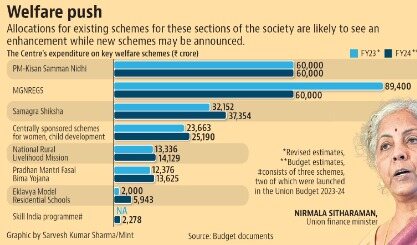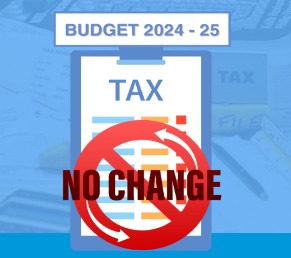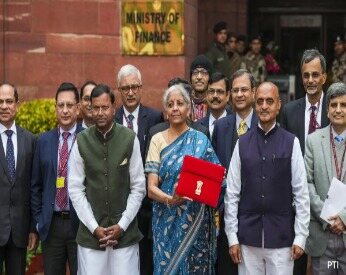The Interim Budget for the fiscal year 2024 was recently announced by the Union Finance Minister, Nirmala Sitharaman on February 1. She presented it for the sixth time and was the shortest budget. This was an interim budget ahead of the general elections later this year. The budget reflects the current economic landscape, considering factors such as GDP growth, inflation rates, and fiscal deficit projections.
Finance Minister Nirmala Sitharaaman said that the government focus was on four major ‘castes’ – Women, Youth, Poor, and Farmers(Annadata). FY25 fiscal deficit is being lowered to 5.1% of the GDP. Also, there were no changes made to the direct tax and indirect tax rates, including import duties.
Economic Transformation and Vision
India has experienced a significant positive transformation over the last decade. It also has three consecutive years of 7% GDP growth and is the fastest-growing economy in G20. The government under PM Narendra Modi, has focused on inlusive growth with the mantra “Sabka Saath, Sabka Vikas, Sabka Vishwas”. The Interim budget sets the foundation for the vision of a “Viksit Bharat”(Developed India) by 2047, focusing on demographic, democratic, and diversity strengths.
The introduction of structural reforms and pro-people programs has led to new employment and entrepreneurship opportunities. This budget further strengthens the policy following which 25 crore people of the country have come out of poverty in the last 10 years. Commitment to national development with new inspirations and resolutions, termed ‘Kartavya Kaal’(Era of Duty) is taken.
Budget in numbers
The government expenditure or the public funds allocated for various purposes such as infrastructure, development, social welfare programs etc can be summarised in the following points:-
- 300 units: Free electricity to be provided per month to 10 million households through rooftop solarization.
- ₹ 11.1 trillion: Capital expenditure budgeted for 2024-25, up 11% from the 2023-24 allocation.
- 100 MT: Capacity for coal gasification and liquefaction to be set up by 2030 as part of net zero progress.
- ₹ 27.6 trillion: Revised estimate for total non-debt receipts for 2023-24.
- ₹ 44.9 trillion: Revised estimate for total expenditure for 2023-24, slightly lower than the budgeted ₹ 45 trillion.
- 1.3 trillion: Total outlay for the 50-year interest-free loans for capex to states.
- 5.1 %: Target for the fiscal deficit as a share of GDP for 2024-25.
- 14,1 trillion: Gross market borrowings through dated securities aimed for 2024-25.
- 10 million: Number of taxpayers likely to benefit from the withdrawal of historical tax demands until 2014-15.
- 86,000 crore: Budgeted expenditure for MGNERAGAS in 2024-25, same as the revised estimate for 2023-24.
Economic and fiscal management
The budget outlines a multi-pronged economic management strategy, including infrastructural development, digital public infrastructure, and tax reforms. The revised fiscal deficit is estimated at 5.8% of GDP for 2023-24, to reduce it below 4.4% by 2025-26.
Inflation has moderated and is within the target band (2%-6%). Spends on capital expenditure have been increased to 11.1 lakh crore for 2024-25.

Sector-specific initiatives
A significant focus on agriculture has been laid by budget, with initiatives like Nano DAP and Atmanirbhar Oilseeds Abhiyaan-Stategy, to be formulated to achieve Atmanirbharta for oilseeds. Development programs for fisheries and dairy such as Pradhan Mantri Matsaya Sampada Yojana to enhance aquaculture productivity and formulation of government policies to support dairy farmers and defeat foot and mouth diseases have been talked about.
Healthcare initiatives, including the expansion of Ayushman Bharat to all ASHA, Anganwadi workers and helpers, and Cervical Cancer Vaccination for girls(9-14 years) have been included in the budget. The budget also emphasises on youth through education and skill development, support for startups, and sports achievements. The empowerment of women in rural areas has also been taken into account.
30 crore Mudra Yojana loans are disbursed to women entrepreneurs. Also, 1 crore women are to be assisted by 83 lakh SHGs to become Lakhpati Didis. Regarding Housing, an additional 2 crore houses are targeted for the next 5 years under Pradhan Mantri Awas Yojana(Grameen). Housing for Middle-Class Scheme to be launched to encourage the middle class to buy/build their own houses.
Infrastructure and environmental initiatives
Massive capital expenditure outlay, development of major railway corridors, and expansion of the aviation sector have been the topics of the interim budget. Implementation of 3 major railway corridor programmes under PM Gati Shakti- energy, mineral and cement corridors is under the light. Also, a port connectivity corridor and a high-traffic density corridor are a part of it. 40,000 normal rail bogeys will be converted to Vnade Bharat standards.
Focus on green energy, including offshore wind energy, coal gasification and bio-manufacturing is one of the highlights of the budget. Promotion of electric vehicles and the establishment of a bio-manufacturing and bio-foundry scheme.
Tourism and investment promotion
The budget also mentions the comprehensive development of tourist centres and infrastructure projects to boost domestic tourism. It will be taken up on Indian islands, including Lakshadweep. Foreign Direct Investment (FDI) inflows marked a significant increase, with continued efforts to attract more foreign investment.
Also, ₹ 1 lakh crore fund is allocated to support technology research. Deep technology for defence is the new pathway. The budget also talks about building digital infrastructure and 3000 new ITIs.
Tax reforms and ease of doing business
The rationalization of direct and indirect tax rates, including GST, to ease the tax burden and improve compliance tax liability for taxpayers up to 7 lakhs under the new tax regime has been introduced through the budget.
Proposals to withdraw outstanding direct tax demands up to Rs. 25,000 for years up to 2009-10 and Rs. 10,000 for the period from 2010 to 2015 for small amounts, benefiting about a crore taxpayers have been laid.

Conclusion
The Interim Budget 2024-25, reflect the government’s continued focus on Inclusive growth, economic stability, strategic global positioning, sector-specific developments, environmental sustainability, and tax reforms, with an overarching vision towards a developed India by 2047.
By allocating resources strategically and focusing on key priorities, the budget aims to propel the nation towards sustainable prosperity and resilience in the face of uncertainty.
-TANYA SHAH
MUST READ: “NARI SHAKTI”: ALL-WOMEN TRI-SERVICE CONTINGENT ROARS WOMEN EMPOWERMENT


